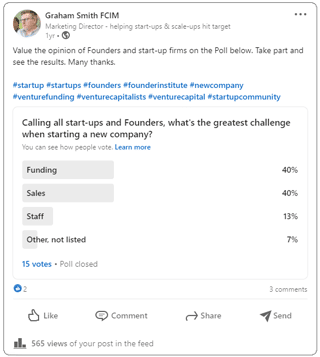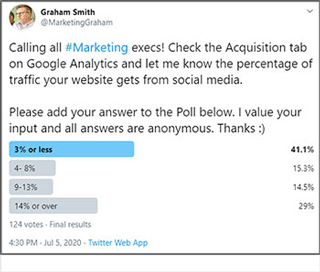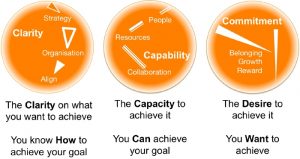Social media is popular among B2B marketers. Partly because it’s the main question they will be asked in their next job interview, partly because it’s considered free (not true) and partly because, well, it can be exciting. But without a strategy it will fail.
Like any other marketing channel, before you start the deep dive into social media strategy you need to decide on your goals. Do you want greater engagement (Likes, Clicks, Shares, Comments) or are you looking for sales leads? Or perhaps something else?
Personally, I don’t value engagement on social media. I think ‘Likes’ are largely a vanity metric. There’s evidence that a person who Likes your social media posts is no more likely to buy from you than somebody that doesn’t (see ‘Stop counting Likes – it’s a waste of time‘).
Where I believe social media does score is in paid lead generation (principally LinkedIn), as a research tool (LinkedIn and Twitter) and as a nurturing tool for those that are not yet ready to buy (positioning you as a Subject Matter Expert).
Market research
Before you begin any campaign or programme I hope you will do market research to understand the needs, wants and pains of your target audience(s). LinkedIn is very good for B2B market research and Twitter is a fast, low-cost alternative.
Both enable you to ask a single question but with limited multiple-choice answers. That’s valuable. Especially as the results can sometimes form the basis for a piece of content (blog article, video, etc.)

LinkedIn currently limits the running time for your poll to 2 weeks and you have only 140 characters for your question. Plus you can only list 4 possible answers (see example).
In addition, you cannot pay to promote your poll. Its success will depend on your personal LinkedIn popularity and the popularity of the poll question.
(Your personal popularity will depend on how much original content you have posted on LinkedIn, whether you comment on other people’s posts and the consistency with which you engage on the platform.)
However, you can copy a link to your poll and then create a separate post directing people to engage. That post can be a paid promotion to a targeted audience 
The other good news is that LinkedIn’s algorithm seems at the moment (January 2022) to be really keen on polls. Polls appear to get greater distribution than other posts.

I like Twitter polls. They are low-cost, targeted (depending on your audience) and fast. Great when I need some stats to back up an article I’m writing. Typically you can get over 100 responses within two days for £20-£50.
The limitations are you only have 280 characters for the question and just 4 possible answers (see example), plus your poll can only run for a maximum of 7 days.
However, you can pay to promote it to a targeted audience. Although the success of targeting is variable. Targeting HR executives is relatively easy (aim for followers of HR Magazine or The Chartered Institute of Personnel and Development), but pinpointing Office Managers is virtually impossible.
Whatever method you use, make sure the results are valid.
Subject Matter Expert
Your organisation will no doubt have some experts (you may be one of them), and your market research may have revealed an interesting fact that you can tell the world. Now it’s time to release your thoughts on social media.
Distributing your content on social platforms will not necessarily deliver a sales lead. It might, but that is not its purpose. The aim is to position you as a thought leader and subject matter expert to those who are not yet ready to buy. You’re nurturing the buying team.
Sometimes the sales process can be lengthy and you need to keep your organisation’s name front of mind. Content that teaches the buying team something they didn’t already know has a role to play.
You can of course distribute the content via other channels (email?). But successful marketing has always been multi-channel; as an example, a mix of email, Google ads and social media make sense.
LinkedIn in particular enables you to target specific people at specific firms with your content.
Imagine you have made contact with a senior executive at British Airways but they have indicated the company is in a contract for the next 6 months. You’ll become a nuisance if you call them every month, so target them (and their buying team colleagues) with your content.
For example, I just ran a sample campaign through LinkedIn targeting Heads of Department and Directors at British Airways. The total was 600 individuals within the UK.
A single image advertisement promoting a piece of content would cost between £23-£100 every 30 days. LinkedIn estimates the campaign would produce 30-98 engagements every 30 days (an engagement is a share, like, comment, view, click or follow)
Paid lead generation
Organic lead generation on LinkedIn is very time-consuming. You want a shortcut to sales leads? You have to pay.
Organic leads are often considered free, so there is a temptation to ‘give it a try’. But they are not free. The amount of time you will spend creating and submitting posts (and your time has a cost) means it’s actually quite expensive for sporadic reward.
(If you insist on trying organic, the best times to post are 7-8am and 5-6pm)
All of the social media platforms have become monetised. They’ve altered their algorithms so that paid posts generate more leads than organic ones. They want you to spend money.
But the cost is not prohibitive and the targeting can be very accurate.
If you wanted to target Airline Directors and C-level executives based in the UK, LinkedIn says its total reach is 10,000 people. It would cost you between £290-£1178 every 30 days for a single image advertisement, and LinkedIn estimates it can deliver up to 30 leads every 30 days for the duration of the campaign.
The lead generation campaigns on LinkedIn are frictionless for your audience. They see the advert, click a link and get taken to a pre-filled form which they can choose to submit (or not).
Connecting the dots to form a strategy
So the strategy I often use is to start by understanding my audience via social media research. What are their needs and wants? Which pains are they discussing in forums? What topics seem to be trending?
Armed with this insight I can start to create relevant content that can be used to nurture existing prospects (who are not ready to buy), and also attract new prospects looking for an expert.
To generate sales leads within a specific time frame I pay for lead generation. Granular targeting by area, industry, job title and interests plus a whole host of other options to ensure I deliver the most relevant message.
Photo by The Creative Exchange
Digital & Social Articles on Business 2 Community
(22)




